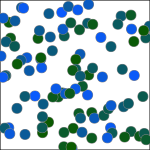Wednesday, May 26, 2010 at 2:26 PM
Did you know gadgets can use html5? The key is in the doctype. Normally the doctype of a gadget isn't mentioned. Specify the html5 doctype in the gadget and it will be used when the gadget is rendered. Let's look at a quick example using the popular canvas drawing API:
<?xml version="1.0" encoding="UTF-8" ?>
<Module>
<ModulePrefs title="html5 canvas">
</ModulePrefs>
<Content type="html" view="home,canvas">
<![CDATA[
<!DOCTYPE html>
<script>
var demo = {
init: function() {
var drawcan = document.getElementById('drawarea');
if (drawcan.getContext){
var context = drawcan.getContext('2d');
var xmax = drawcan.width;
var ymax = drawcan.height;
context.strokeRect(0,0,xmax,ymax);
for (var dotix = 0; dotix < 100; ++dotix) {
var x = Math.random() * xmax;var y = Math.random() * ymax;
context.strokeStyle = "#888888";
var blueness = Math.floor(Math.random() * 256);
context.fillStyle = "rgb(10,90,"+ blueness +")";
context.beginPath();
context.arc(x,y,5,0,Math.PI*2,true);
context.closePath();
context.stroke();
context.fill();
}
}
}
};
gadgets.util.registerOnLoadHandler(demo.init);
</script>
<canvas id="drawarea" width="150" height="150"></canvas>
]]>
</Content>
</Module>

The top of the gadget still has the usual XML prolog because the gadget spec is, as always, an XML document. The html, in this case html5, is inside a CDATA block. The CDATA block means the structure of the html5 content is pretty much ignored when parsing the XML. iGoogle doesn't do anything extra for compatibility with html5; features specific to html5 will still only work in browsers that support them. Gadgets have the same cross-browser compatibility concerns as any other web page. Have a look at the When can I use guide for an idea of compatibility of features across browsers.
The content of this gadget is pretty straightforward. It includes a canvas element. In the init method it tries to get a drawing context. If it's successful (meaning the browsers supports html5 canvas) it will draw a rectangle around the extents of the element then draw 10 randomly placed dots inside. Use this gadget as a starting point to get your own html5 gadget running.
And yes, this gadget has a canvas in your canvas so you can render when you render.